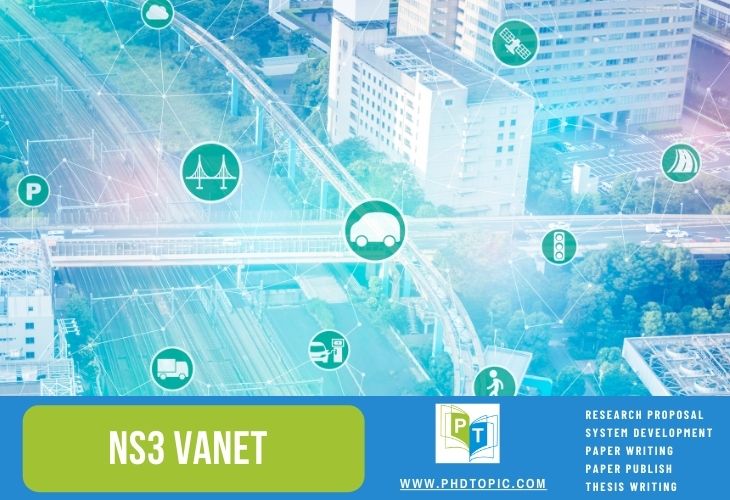Vehicular communication systems are intended to enhance the intelligent transportation system (ITS) utilizing reliable communication among vehicles with roadside units (RSUs). In VANET, it connects the vehicles with other interacting nodes such as vehicles, RSUs, pedestrians, or surrounding objects. From the viewpoint of ITS or VANET, it shares the information either inside or outside of the network in both cases of normal and emergencies.
For instance, safety warnings, traffic/parking information are developed nowadays as ITS applications. Overall, it provides the best services for infotainment, traffic efficiency, highway safety, smart transportation, etc.
This page brings out more information on NS3 VANET simulation with their latest research modernization!!!
Because of the enriched characteristics of VANET as mobility and self-directing, it gains more attention in the research community. And, it motivates both academic individual and master researchers to conduct research and experiments in big/small scale vehicular communications.
Why simulation is required for VANET?
When we work on a big-scale network, it is important to assess the performance and efficiency of the application in the distributed system. For example, if someone is working on traffic management in a metropolitan network, then the network must focus on the security and routing protocols in current research. Compare to simulation, real-world implementation is expensive and practically hard to assess the protocols for big-scale networks.
 Overview of NS3 in VANET
Overview of NS3 in VANET
In fact, NS-3 is a popularly used discrete-event-based network simulation tool for developing VANET applications and services. Majorly, it supports different protocols which are capable to support huge nodes and network traffic. More than the other simulators, NS-3 provides high performance.
Generally in VANET, the nodes will freely and randomly move their position to interact with the surrounding neighbors in the coverage area. So, it is essential to find which node will receive the packets at the time of wireless transmission. Most importantly, we need to accurately predict the accessible nodes for efficient packet forwarding.
First and foremost, our research service is very precise in delivering novel VANET systems. Since we usually upgrade our knowledge on both current and future research technologies. Once you make a bond with us, let you find answers for the following questions,
- What are the topics currently available in your interested VANET areas?
- What is the procedure to configure the desired scenario for various environs?
- By what means, we need to define a scenario for VANET assessment?
Research Challenges of NS3 in VANET
In recent times, the simulation of the huge-scale network is quite a challenging process, particularly in VANET developments. If you are dealing with a huge network, then it is necessary to concentrate on communication protocols design for any kind of application. Since the handling of large-scale nodes in real environs is a tedious process. So, the simulation process needs more concern for selecting appropriate methodologies.
Though the NS-3 tool is widely used for several applications development, it is lacking in scalability which results in constrained performance. So, it gives the best result in the medium-sized network. For increasing the understand ability, here we have given you the list of network operations and entities that are required for building VANET scenarios.
What are the components used for VANET scenario creation?
- Network Routing Protocols Ad-hoc Routing Standards
- IPv4 or IPv6
- Streaming and Clustering
- Network Communication Devices
- Wi-Fi (infrastructure and ad-hoc network)
- LTE, WAVE, Cabled Peer-to-Peer and etc.
- Network Nodes and Devices
- Dynamic Moving Vehicles
- Fixed RSUs or Traffic Lights
- Components (in both fixed and dynamic nature)
- Network Applications
- Online or Offline based Generic
- ITS-centric (BSM)
- Ping and many more
Next, we can see how the VANET environment is designed and configured in NS3 Simulator. Here, we have given the key points to create scenarios, deploy nodes, choose mobility models, and more. And, this is common for general VANET projects in NS3 further it may vary based on project needs.
How to set up NS3 for VANET?
- Determining Network Scenarios
-
- Form the highway at a constant speed
- Create the urban environment (trace file of Manhattan Grid)
- Set the parking space in fixed mode
- Other, Settings / Environs
- Infrastructure based Adhoc Network
- Non-QoS or QoS (QoS stands for Quality of Services)
- Protocols of IEEE 802.11a, IEEE 802.11g, and IEEE 802.11b
- Design and deploy all necessary nodes in the created environment before simulation
- Perform initial node placements based on Position Allocators
- For example Random, Static (Grid and List), etc.
- Define the Mobility models to represent in what way the nodes are changing their position
- Google API based Paths Mobility
- Random Waypoint, Constant (Position and Speed), etc.
- Create trace-file from mobility tools like NS2 based BonnMotion and SUMO
Our developers’ primary focus in this field is to design and develop unbeatable NS3 VANET projects. Since we have plentiful knowledge on both important and growing techniques of NS3 and VANET. And, if there is a requirement then we are fast in designing new algorithms/protocols to tackle the problem in a smart way. Below, we have given you a few widely used NS3 modules for VANET simulation.
NS3 Modules for VANET
- #include
-
- <iostream>
- “ns3/integer.h”
- “ns3/wave-helper.h”
- “ns3/dsr-module.h”
- “ns3/aodv-module.h”
- “ns3/core-module.h”
- “ns3/olsr-module.h”
- “ns3/internet-module.h”
- “ns3/ocb-wifi-mac.h”
- “ns3/wave-mac-helper.h”
- “ns3/dsdv-module.h”
- “ns3/mobility-module.h”
- “ns3/wave-bsm-helper.h”
- “ns3/wifi-80211p-helper.h”
- “ns3/config-store-module.h”
- “ns3/network-module.h”
- “ns3/applications-module.h”
- “ns3/yans-wifi-helper.h”
- “ns3/flow-monitor-module.h”
- “ns3/itu-r-1411-los-propagation-loss-model.h”
In the above, each module supports a specific set of libraries for network functionalities. For illustration purposes, here we have selected the “WiFi” module. Let’s see the few important characteristics of WiFi modules with their advanced capabilities. Similarly, we are well-experienced in handling other modules to provide the best results.
- WiFi Module Characteristics
-
- Support both ad-hoc and infrastructure environments
- Provide quality of service for EDCA
- Accumulation of MPDU and MSDU
- Offer techniques and procedures for rate adaptation
- Integrates CTS / RTS and other fundamentals for DCF employment
- Include IEEE 802.11a, IEEE 802.11n, IEEE 802.11b, and IEEE 802.11g for physical layer at 2.4 GHz and 5 GHz
- Support packet – level based execution
- Ability to facilitate inter-technology intervention
- Design and Simulate the power spectral density of every communication
- Enable several new models as given below,
- SpectrumWifiPhy – Currently in progress under incomplete state and delayed process
- YansWifiPhy – Commonly used default model
- PhySimWifi – Perform at symbol-level but take more time for implementation
Similarly, Millicar is another popular ns-3 Module for mmWave NR under V2X Networks. To support future technologies of Vehicular systems, as 3GPP protocol and New Radio V2X specifications are introduced in sideline MAC and PHY layers. The NS-3 module is furnished with these features to support up-to-date technologies.
Here, we have given some key functions involved in the NS-3 module
In the simulation framework, configure the all-important parameters required for designing and developing network models using the config attribute in the NS-3 module. Some of the parameters are system bandwidth, buffer size, RLC type, carrier frequency, etc. And, we can also decide whether AMC is required or not depends on the parameters.
- Set the MmWaveHelper object for designing channel models
- Create the nodes to be placed and set the positions and mobility model used for deployed nodes
- Allocate IP address for each vehicle and set the TCP/IP stack
- Configure and install the applications and MmWaveVehicularNetDevice objects for nodes
For instance: In the simulation infrastructure, it comprises both communication and traffic simulator for the integration of simulator multi-user driving simulator.
Therefore, this infrastructure enables multiple users (i.e., human drivers) to concurrently interact with others. Through this trial, we can evaluate the performance of both individual and overall communication.
Now, we can see about the mobility models that are flexible to incorporate with the NS3 simulation tool. These integrated tools are well-equipped with more libraries and modules to develop all forms of complex scenarios in VANET. Our developers are ready to assist you to frame smart solutions for your research problem at any level of complexity.
 Integrated NS3 Simulators
Integrated NS3 Simulators
- Web-based integration of mobility model with the NS-3 simulator
-
- Veins
-
-
- Simulation Tool
-
-
-
-
- Application – TraCI
- Traffic – SUMO
- Communication – OMNeT++
- Category – Static Coupling
-
- TraNS
- Simulation Tool
- Application – TraCI
- Traffic – SUMO
- Communication – NS-2
- Category – Static Coupling
- Simulation Tool
- iTETRIS
- Simulation Tool
- Application – TraCI
- Traffic – SUMO
- Communication – NS-3.18
- Category – Static Coupling
- Offer end-to-end ETSI ITS stack
- Simulation Tool
- VNS
- Category – Loosely Coupled
- Coupled with ns-3.16
- Paramics and NS-2
- Simulation Tool
- Application – Paramics
- Traffic – Paramics
- Communication – NS-2
- Category – Static Coupling
- Simulation Tool
- VSimRTI
- Simulation Tool
- Application – VSimRTI_App
- Traffic – SUMO / VISSIM
- Communication – JiST / SWANS and OMNeT++
- Category – Use different simulators
- Can integrate with ns-3.15
- Simulation Tool
- ONVIS
- Coupled with ns-3.10
-
In addition, we have also given you the current research interest of scholars who wish to create the stroke of genius in the VANET field. Our experts have highlighted only a few for your awareness, beyond these we are still working on other significant areas.
Latest Technologies using VANET
- Aerial based Data Capturing (Sensing)
-
- Co-existence and Scalability
- UAV-based Transport
- Constrained Power Utilization
- Optimization of Joint Route
- Active Aerial Network Establishment
- Interference Control
- Hovering of Cluster
- Positioning of 3D relay
- Pre-emptive Data Transmission
- Mesh Routing and Multi-Rat based Communication Channel Selection
- Prediction of Beam steering and Data Rate
On the whole, we are glad to inform you that we serve you in every aspect of NS3 VANET research. In specific, we support you in topic selection in interesting areas, research solution framing for the handpicked problem, practical development, and manuscript writing.
